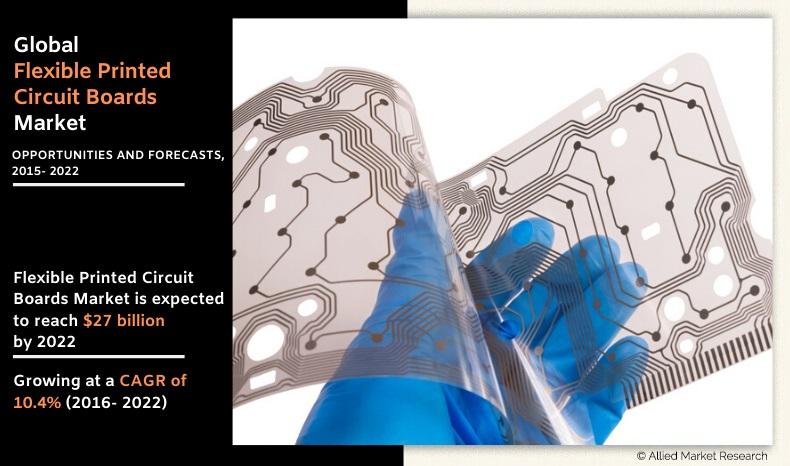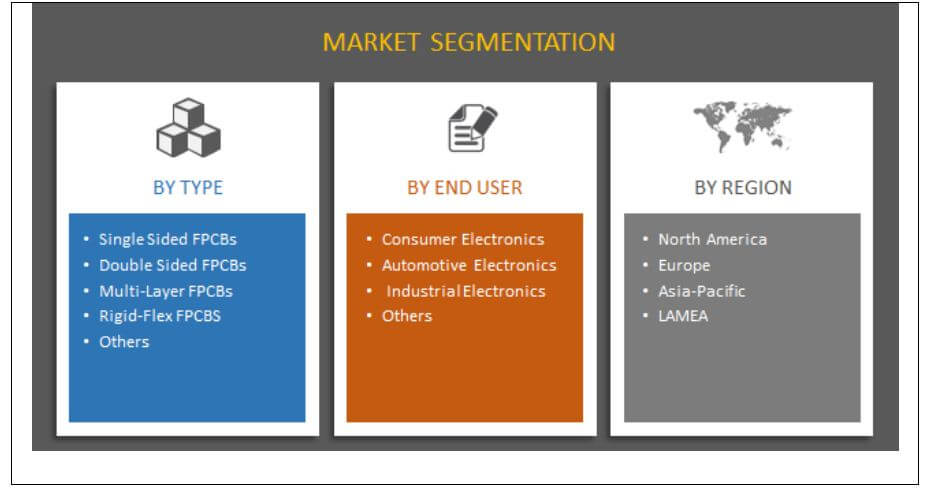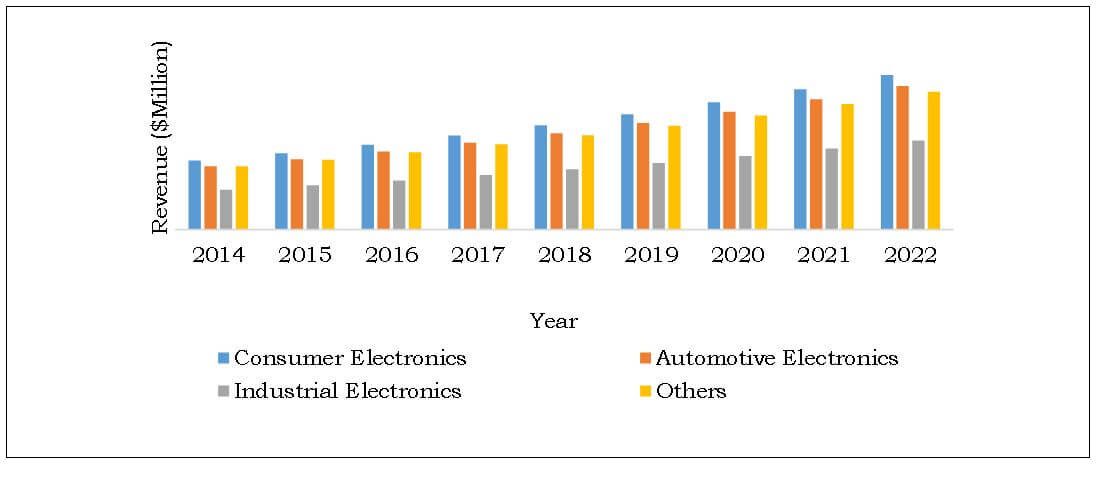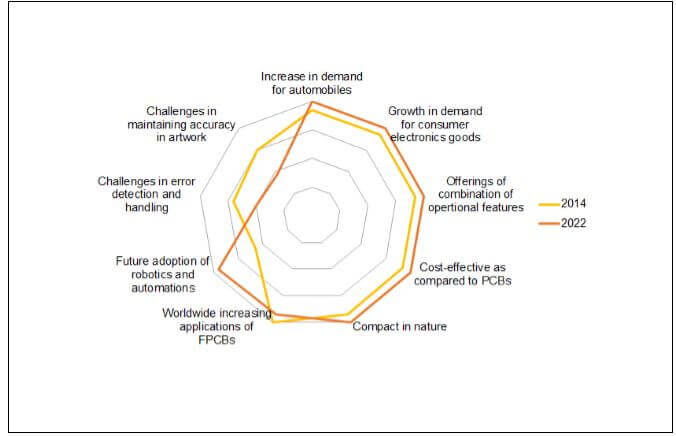Flexible Printed Circuit Boards (FPCBs) Market Overview
Global Flexible Printed Circuit Boards (FPCBs) Market is anticipated to reach around $27 billion by 2022, growing at a CAGR of 10.4% from 2016 to 2022. Flexible PCBs are highly efficient interconnectivity solutions used for a wide range of electronic devices with complex circuitry. These PCBs are traces of conductive material on a flexible substrate and are used to avoid complex structuring of wiring and other connections. Flexible PCBs are also utilized for efficient interconnection between electronic components such as integrated circuits, capacitors, and resistors.
Advantages such as lightweight and economical nature, simple structuring, and design freedom drive the growth of the flexible PCBs market. Factors such as reliable applications, high packaging flexibility, and quality performance are further projected to favor this growth. Rise in demand and production of consumer electronic devices such as cellular phones has a significant favorable effect on the market growth.
Segment Overview
The report provides an in-depth overview of the global FPCBs market, which includes FPCBs manufacturers, raw material suppliers, and end users. Furthermore, the study assists the stakeholders to focus on the market segments which are expected to provide highest returns in the coming years. Manufacturers also focus on innovative products and have adopted partnership and acquisition to expand their customer base and increase their market shares.
The FPCBs market is segmented on the basis of type, end user, and geography. By product type, it is divided into single-sided FPCBs, double-sided FPCBs, multilayer FPCBs, rigid-flex FPCBs, and others. By end user, it is classified into consumer electronics, automotive electronics, industrial electronics, and others. Based on geography, it is analyzed across North America, Europe, Asia-Pacific, and LAMEA. Asia-Pacific accounted for the largest revenue share, owing to the increase in demand for semiconductor and portable devices.
Global FPCBs Market Segmentation
Market by End User
Competition Analysis
Comprehensive competitive analyses and profiles of major market players, including NOK Corporation (Nippon Mektron Ltd.), Sumitomo Electric Industries, Ltd. (SEI), Fujikura Ltd., Multi-Fineline Electronix, Inc., Zhen Ding Technology Holding Limited (ZDT), Nitto Denko Corp., Interflex Co., Ltd., Career Technology, FLEXium Interconnect, Inc., and ICHIA Technologies Inc., are provided. Currently, the players in the FPCBs market have adopted partnership and acquisition to expand their customer base and increase their shares.
Top Impacting Factors Of Fpcbs Market
Growth In Demand For Consumer Electronic Goods
Maintenance of compact nature of the device along with optimum wirings for interconnectivity is the major challenge faced by the mobile market. To overcome this barrier, majority of mobile manufacturers focus on more efficient flexible PCBs solutions. FPCBs are applicable in consumer electronics such as mobile phones, LCD display, connectivity antennas, and flexible circuitry used in rechargeable batteries. With rise in demand and production of these devices, the market growth is projected to increase. FPCBs provide significant interconnectivity solutions for such electronic devices.
Cost-Effective As Compared To Pcbs
Flexible PCBs are compact in nature due to absence of complex wiring required for interconnections, thus being significantly used for high density of electrical connectivity. Use of FPCBs significantly reduces the total cost involved in providing interconnectivity solutions. Currently, FPCBs are more reliable and major replacement for traditional wirings used in devices.
Key Benefits
- The study provides an in-depth analysis of the global FPCBs market to elucidate the prominent investment pockets.
- Current trends and future estimations are outlined to determine the overall market potential and single out profitable trends to gain a stronger foothold.
- It presents information about key drivers, restraints, and opportunities along with their impact analyses.
- The market is analyzed based on various regions, namely, North America, Europe, Asia-Pacific, and LAMEA.
- Value chain analysis enables better understanding of the roles of intermediaries in the production processes.
Flexible Printed Circuit Boards Market Report Highlights
| Aspects | Details |
| By Type |
|
| By End User |
|
| By Geography |
|
| Key Market Players | Zhen Ding Technology Holding Limited (ZDT), Fujikura Ltd., Interflex Co., Ltd., Sumitomo Electric Industries, Ltd. (SEI), ICHIA TECHNOLOGIES Inc., Multi-Fineline Electronix, Inc., Career Technology, NOK Corporation (NIPPON MEKTRON LTD.), Nitto Denko Corp., FLEXium Interconnect, Inc. |
Analyst Review
The global flexible printed circuit boards (FPCBs) market is expected to witness significant growth in the near future, owing to growth in sales of consumer electronics and automobiles. Flexible PCBs are designed to overcome limitations of rigid PCBs and manual wiring. Printed circuit boards (PCBs) were used earlier in industrial systems for data transmission. However, other industries, such as consumer electronics, energy & power, inverter & UPS, and automotive, have adopted FPCB to efficiently manage data transfer, owing to the advent of advanced technology and increase in awareness about the benefits of FPCB technology. Market players have focused on the development of innovative products for applications in telecommunication and electronic appliances to enhance their efficiency. FPCB enable high-frequency data transfer to improve efficiency and prevent power loss. Low power consumption and intense competition have resulted in industries adopting multilayer FPCBs, which has stimulated the market growth.
Numerous advantages such as lightweight nature, simple structuring, cost saving, and design freedom drive the market growth. However, challenges in error detection & handling methodologies and maintaining accuracy in artwork hamper the market growth. Nevertheless, adoption of FPCBs in flexible diode display used in organic light-emitting diodes (OLED) and flexible solar cells, and increase in demand for high-frequency electronic gadgets provide various growth opportunities to market players. However, prominent players have developed low-cost, compact, affordable, and energy-efficient printing techniques to increase the efficiency of the applications. Asia-Pacific is the major revenue contributor to the global market, followed by North America. It is projected that the market growth in North America and LAMEA is expected to significantly increase during the forecast period.
Loading Table Of Content...







